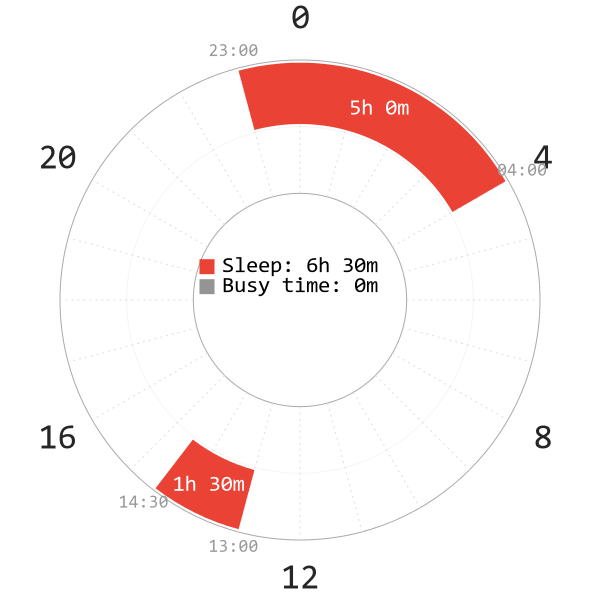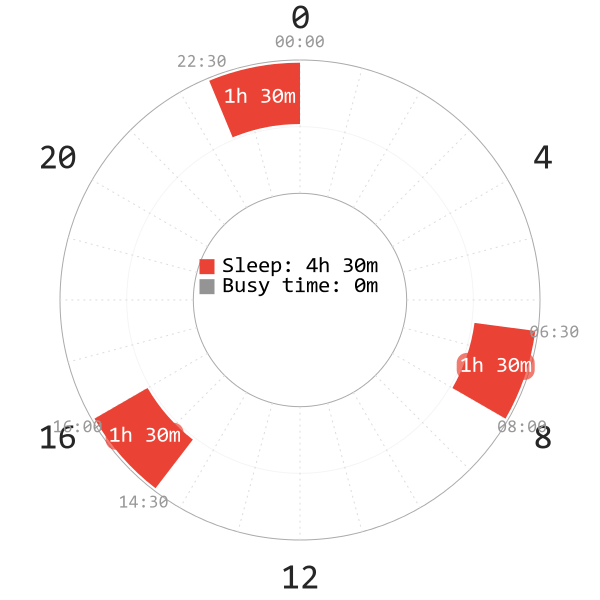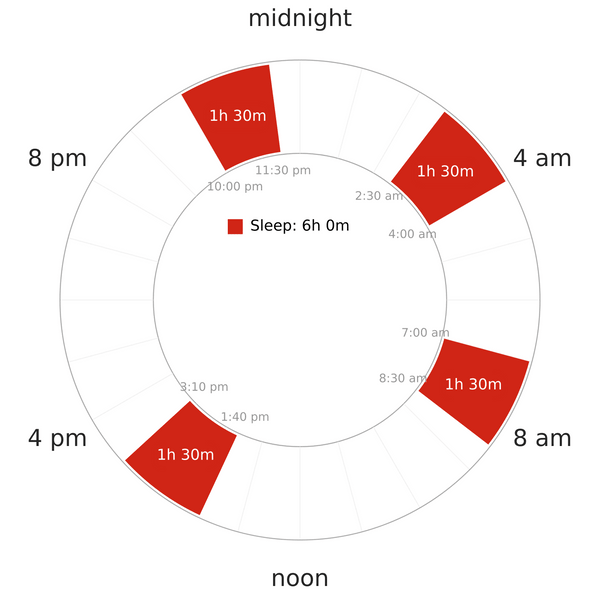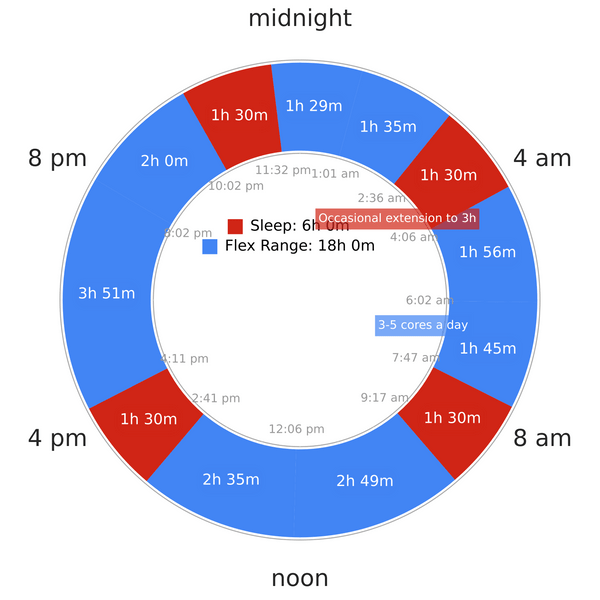CORE-ONLY
Core-only polyphasic schedules may appear like a novel concept to first-time polyphasic sleepers. However, many in the world have practiced some kind of core-only pattern, whether intentionally or not. The immediately noticeable trait of these schedules is that they contain exclusively core sleeps, the opposite of nap-only schedules.
The goal of this post is to further examine human sleep behavior under the condition of sleeping in multiple core sleeps.
In the context of polyphasic sleeping, any sleep duration with at least 1 full sleep cycle (80-120m) is a core sleep.
- Siesta sleep, which contains a shorter daytime core of 90m, is the most popular core-only polyphasic schedule.
- Segmented sleep is also popular in the world, from past to present.
- Triphasic sleep’s debut in the 2000s marked the first core-only schedule with more than 2 sleep blocks per day.
- The dominant characteristic of these schedules is that the core sleeps concentrate around night time hours.
- Usually, only one daytime sleep block resides during daytime hours, which dedicates waking hours to other daily life commitments.
- Because of the daytime core, these schedules (bar Segmented sleep) have much fewer attempts than schedules with short daytime naps.
- It is generally harder to adapt to these schedules (bar Siesta and Segmented) than to Everyman schedules due to the split sleep mechanics.
Variations
Under some scheduling variations, core-only schedules can inherit from the traits of Dual Core sleep (e.g, waking at night). Depending on scheduling, they may also look like “intentionally interrupted monophasic sleep”. Recently, there have been more discoveries that enhance their overall flexibility and scheduling viability. Regardless, exposure to a core-only sleep system may be a unique polyphasic experience.
Segmented (7 hours)
- Invented by: N/A, historically used by humans.
- Total sleep: 7 hours.
- Classification: Biphasic schedule in a Dual Core style.
- Specification: 2 core sleeps, with a short gap between them.
- Mechanism: Two sleeps per day, with one sleep in the first half of the night that gives mostly SWS. In addition, another sleep in the second half of the night gives mostly REM. There is usually a 3-hour wake between 2 cores to trigger sleep stage division within them.
- Adaptation difficulty: Moderate.
- Ideal scheduling: 1 core around 21:00, should not be later than 22:00ish, 1 core till morning.
Siesta (6 hrs 30 mins)
- Invented by: N/A, historically used by humans.
- Total sleep: 6 hours 30 minutes.
- Classification: Biphasic schedule.
- Specification: 1 long core + 1 short core, placed roughly opposite each other.
- Mechanism: Two sleeps per day. The core occupies most of the night. In addition, there is a long sleep block around noon.
- Adaptation difficulty: Moderate.
- Ideal scheduling: Core around midnight, siesta at noon.
Triphasic (4 hrs 30 mins)
- Invented by: Leif Weaver.
- Alternatively known as: Tri Core 0, TC0.
- Total sleep: 4 hours 30 minutes.
- Classification: Tri Core schedule.
- Specification: 3 cores of minimum length.
- Mechanism: One core sleep before midnight, one around dawn, and one around noon. SWS and REM go into 2 night cores, like Dual Core sleep. Lastly, there is a long siesta to balance out the schedule.
- Adaptation difficulty: Hard.
- Ideal scheduling: One core sleep around 21:00, one around 05:30, one around noon.
Quad Core 0 (6 hours)
- Invented by: GeneralNguyen.
- Alternatively known as: Quadphasic, Four Core 0 (FC0), Quad Core, 4C0.
- Total sleep: 6 hours.
- Classification: Quad Core schedule.
- Specification: 4 cores of 1 cycle length.
- Mechanism: One core sleep before or around midnight, one around dawn, and one around noon. Similar to Dual Core sleep, 2 cores around SWS & REM peaks contain higher amounts of SWS and REM respectively. Long siesta and another core in graveyard hours to balance out the schedule and give mixed sleep stages. However, it is also possible to schedule a core in later evening hours (e.g, 23:00) thanks to decently high total sleep. It is also possible to have 4 equidistant core sleeps, resembling Dymaxion structure.
- Adaptation difficulty: Hard.
- Ideal scheduling: One core sleep around or before midnight, the next 2 cores are ~2.5-3h apart from each other and the last core is in early/mid afternoon with a longer wake gap.
Core As Much As You Like (CAMAYL)
- Proposed by: GeneralNguyen
- Total sleep: Undefined, but average to be 6h
- Classification: Flexible schedule, SPAMAYL variant, Multi-core variant
- Specification: Multiple core sleeps of 1 cycle each
- Mechanism: Variant of SPAMAYL that includes only core sleeps. Evolves well from adaptation to QC0 and then QC0-flex as a helpful intermediate. Each core sleep provides a distinct amount of sleep stages depending on when they are placed and the level of current homeostatic pressure. A strong reliance on sensing when the most ideal time to place a core is. The freedom to place a core soon in the day at natural tired/sleepy spots is mandatory to make the schedule work. This is to avoid excessively long wake gaps that result in tiredness and potential crash later on.
- Adaptation difficulty: Hard
- Ideal scheduling: 4 core sleeps on average each day; each core sleep lasts for 90m. Core spacing should take into account natural periods of drowsiness and SWS/REM peaks. It is more common to stay awake for longer periods in the day (6+ hours) while shorter periods around graveyard/morning hours (2-3h) between each core. A core sleep can extend to 3h after adaptation to make up for a missing core from the previous day. A short nap (10-15m) can be occasionally added to the schedule (after adapted) for a long wake gap that does not allow a full core. The number of cores taken each day may vary everyday or on an occasional basis.
Comparison between Core-only Schedules
NOTE:
- The assessment table showcases differences between Core-only schedules, based on standard scheduling.
- Unless specified otherwise, there are no mentions on extended versions.
- The table does not account for short sleepers; thus, these criteria will likely vary in them.
- Assessment denotations:
- 4/4: Positive, very high viability, or very easy
- 3/4: Somewhat decent viability, above average, or somewhat easy
- 2/4: Neutral, medium viability
- 1/4: Overall negative, low viability, below average, or difficult
| Criteria | Segmented | Siesta | Triphasic | QC0 | CAMAYL |
| Exercising | |||||
| Time zone travel (> 5h) | |||||
| Evening social time (18:00-23:00) | |||||
| Daytime sleep (07:00-17:30) | N/A | ||||
| Nap around meal time | N/A | ||||
| Overall flexibility | |||||
| Flexible core(s) | |||||
| Hidden potential | First core can start later (~23:00) | Daytime core can be late (after 17:00) | ~9-10h morning wake gap | None | Varying core duration, short nap in emergency |
| Criteria | Segmented | Siesta |
| Exercise | ||
| Time zone travel (> 5h) | ||
| Evening social time (18:00-23:00) | ||
| Daytime sleep (07:00-17:30) | N/A | |
| Sleep around meal time | N/A | |
| Overall flexibility | ||
| Flexible core(s) | ||
| Hidden potential | First core can start later (~23:00) | Daytime core can be scheduled late (after 17:00) |
| Criteria | Triphasic | QC0 |
| Exercise | ||
| Time zone travel (> 5h) | ||
| Evening social time (18:00-23:00) | ||
| Daytime sleep (07:00-17:30) | ||
| Schedule sleep around meals | ||
| Overall flexibility | ||
| Flexible core(s) | ||
| Hidden potential | ~9-10h morning wake gap | None |
| Criteria | CAMAYL |
| Exercising | |
| Time zone travel (> 5h) | |
| Evening social time (18:00-23:00) | |
| Daytime sleep (07:00-17:30) | |
| Schedule sleep around meal time | |
| Overall flexibility | |
| Flexible core(s) | |
| Hidden potential | Varying core duration, addition of short nap possible |
Brief Analysis
- Segmented has the biggest advantages because of no daytime sleep. This would fit more hectic, standard lifestyles that permit no daytime sleep.
- However, all schedules except Segmented are limited to siesta cultures to afford the daytime core sleep. Alternatively, mostly work-from-home occupations can benefit from a long daytime sleep.
- Barring regular Triphasic (4.5h), most schedules reportedly support physical exercise recovery decently well. This mostly has to do with their decent total sleep. In addition, core sleeps also allow longer SWS duration than short naps to optimize recovery output. Siesta is still the best polyphasic schedule for athletes so far, most notably.
- All schedules except regular Triphasic have decent flexibility after adaptation.
- Barring Siesta, the remaining core-only schedules have a hard time with social evening time. Usually, there is a core sleep around the SWS peak. CAMAYL, however, can occasionally remedy this weakness. Still, it is not consistent enough and has to follow body’s pattern of tiredness.
- Scheduling meals around a daytime core is usually more difficult than around a daytime nap. Thus, to protect the core’s quality, meal time scheduling may become more restrictive.
- While most schedules struggle with time zone traveling events, CAMAYL appears to hold up quite well. Its flexible core sleep mechanics can help stay awake for longer hours if required and even extended core later on. However, more data would be necessary to determine its full travelling utility.
- All schedules except Siesta share certain features of Dual Core sleep. This is because they usually have 2 core sleeps around SWS and REM peak hours.
- Core-only schedules may be a better choice for people who cannot fall asleep in short naps. Some rare community cases perpetually fail to fall asleep in short naps (< 30m) or prefer longer sleep.
Main author: GeneralNguyen & Crimson
Page last updated: 10 January 2021













